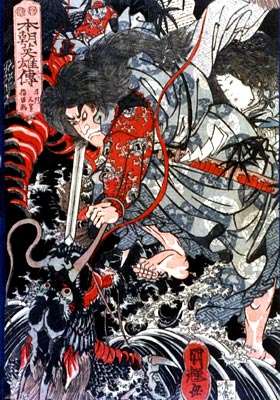Shikome
Yomotsu-shikome (黄泉醜女, lit. "Ugly-Woman-of-the-Underworld"), in Japanese mythology, was a hag sent by the dead Izanami to pursue her husband Izanagi, for shaming her by breaking promise not to see her in her decayed form in the Underworld (Yomi-no-kuni). Also recorded by the name Yomotsu-hisame (泉津日狭女), the name may have been a term referring collectively to eight hags, not just one.
Accounts in mythology
The hag appears by the Yomotsu-shikome (or Ugly-Female-of-Hades"[1]) name in the eldest Japanese chronicle Kojiki. But either eight demon-hags (female oni) or a woman/women named Yomotsu-hisame hunted after Izanagi according to the Nihon Shoki, which frequently gives different readings from alternate sources.
- Kojiki version
Izanagi was fleeing the Underworld with Yomotsu-shikome in hot pursuit. Izanagi first cast down his black headdress,[lower-alpha 1] which turned into a kind of grapes[lower-alpha 2] and slowed the hag's advance as she devoured them. Next he broke off his comb Yutsu-tsuma-gushi ("multitudinous and close-toothed comb" 湯津爪櫛)[lower-alpha 3] and cast them, and the broken piece (the teeth?[2]) turned into bamboo shoots, slowing her down again as she pulled them out and ate them. But the hag was now joined by a large army 1500 strong led by eight Thunder-deities. Izanagi brandished his Totsuka-no-Tsurugi (十拳剣, "ten-grasp saber ") but still they pursued, until he climbed atop the "flat slope" or "Even Pass"[1] at the entrance to the Underworld, and flung three peaches, whereby the pursuers retreated. After this, Izanami herself came in pursuit, and Izanagi blocked the entrance at the slope with a boulder.[1][3]
- Nihon shoki version
Apart from the variant name and the possibility of multiple hags ("eight Ugly Females of Yomi,"[4]) are some minor discrepancies, such as the lack of mention of the Thunder god and the army and the peaches. As Izanagi reached the entrance, Izanami was already there. According to one telling, Izanagi urinated at the large tree, so that the water swelled into a river, and before Yomotsu-hisame could cross it, Izanagi reached the entrance named the "Even Pass of Yomi".[4][5]
Critical literature
Many have commentated on the connection of this story with the peach, which in Japanese and Chinese tradition are held to have supernatural evil-warding powers.[6][7] The symbolism of the "Peach Boy" or Momotarō that defeated the oni is often used as a familiar illustrative parallel.[7]
Notes
- ↑ plant woven into a wreathe (Chamberlain 1882, p. 36, note14), and used to ward off evil (Takeda 1996, p. 29 note18)
- ↑ ebikazura (蒲子), which is Old Japanese for yamabudō (山葡萄, Vitis coignetiae77)(Takeda 1996, p. 29 note19)
- ↑ Izanagi earlier broke off the end of this comb to ignite the fire in order to have a light source to peek at his wife
Citations
- 1 2 3 Chamberlain 1882, p. 36, I.IX The Land of Hades
- ↑ Sweet, Charles Filkins (1919). New life in the oldest empire. Macmillan. pp. 1–7.
- ↑ Takeda, Yūkichi(武田祐吉) (1996) [1977]. 中村啓信, ed. 新訂古事記. 講談社. pp. 27–30. ISBN 4-04-400101-4.
- 1 2 Aston, William George (1896). Nihongi: Chronicles of Japan from the Earliest Times to A.D. 697. 1. London: Japan Society of London. pp. 24–.
- ↑ 宇治谷, 孟 (Tsutomu Ujitani) (1988). 日本書紀. 上. 講談社. pp. 27–8. ISBN 9780802150585.
- ↑ Akagi, Takehiko (赤城毅彦) (2006). 『古事記』『日本書紀』の解明: 作成の動機と作成の方法. 文芸社. p. 238. ISBN 9784286017303. citing sinologist Mitsuji Fukunaga (福永光司), several Chinese use of the peach, including the wood of the bow of the mythic Yi(羿)
- 1 2 小向, 正司 (1992). 神道の本. Books Esoterica. 2. 学研. pp. 27;130–131.(zasshi code 66951-07; kyōtsu zasshi code T10-66951-07-1000)
References
- Chamberlain, Sir Basil Hall (1882). "A Translation of the 'Ko-ji-ki', or Records of Ancient Matters". Transactions of the Asiastic Society of Japan. 10, suppl. Yokohama. pp. 261– (p.36): I.IX The Land of Hades.
- (Reprint) Chamberlain, Sir Basil Hall (1917). "The Kojiki, or Records of Ancient matters". In Horne, Charles Francis. The Sacred Books and Early Literature of the East: With an Historical Survey and Descriptions. 13. Parke. pp. 8–61.Wikisource:
 ""2.1 The Land of Hades".
""2.1 The Land of Hades".
- (Reprint) Chamberlain, Sir Basil Hall (1917). "The Kojiki, or Records of Ancient matters". In Horne, Charles Francis. The Sacred Books and Early Literature of the East: With an Historical Survey and Descriptions. 13. Parke. pp. 8–61.Wikisource:
External links
See also
- Izanami
- Totsuka-no-Tsurugi
- oni (demon)
- Stith Thompson motif D672. Obstacle flight
- Aarne-Thompson Tale Type 313

